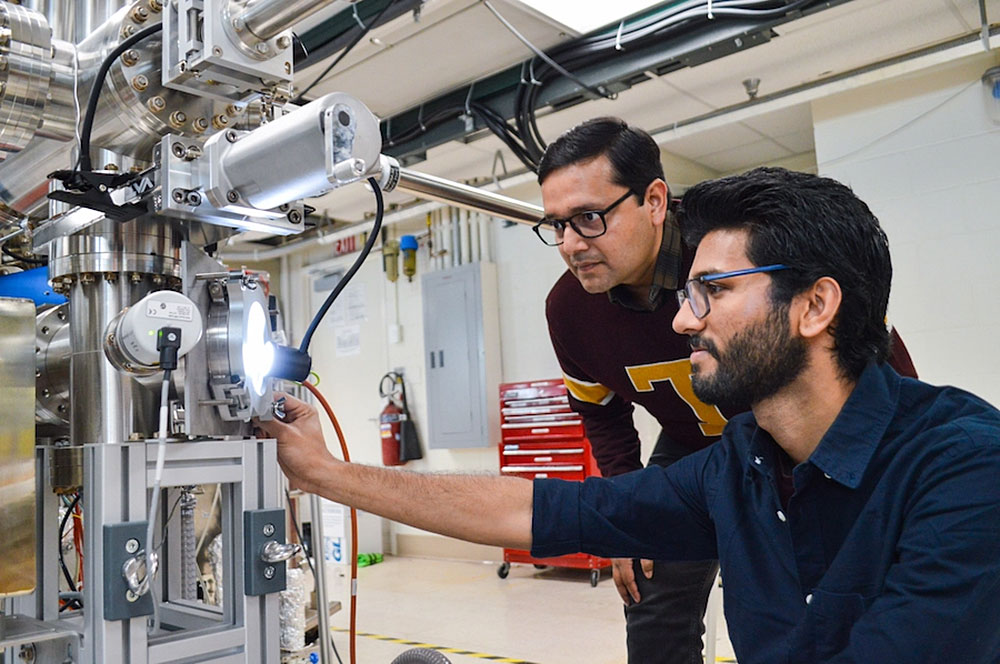Stretching Metals Allows Researchers to Create Materials for Quantum, Electronic and Spintronic Applications
May 25, 2023

Professor Bharat Jalan and Ph.D. candidate Sreejith Nair. Credit: University of Minnesota
The following news release, originally issued by the University of Minnesota (UMN), describes a new method to create thin oxide films from hard-to-oxidize elements like iridium. To develop this method, the UMN researchers collaborated with Jerzy (Jurek) Sadowski, a scientist at the Center for Functional Nanomaterials (CFN). Sadowski used the XPEEM/LEEM endstation at the Electron Spectro-Microscopy (ESM) beamline at the National Synchrotron Light Source II (NSLS-II) to decipher the local structure and surface chemistry of iridium dioxide films. The XPEEM/LEEM endstation is operated by CFN through a partner user agreement with NSLS-II. NSLS-II and CFN are U.S. Department of Energy (DOE) Office of Science User Facilities at DOE’s Brookhaven National Laboratory. For more information on Brookhaven’s role in this research, contact Stephanie Kossman (skossman@bnl.gov, 631-344-8671).
A University of Minnesota-led team has developed a first-of-its-kind, breakthrough method that makes it easier to create high-quality metal oxide thin films out of “stubborn” metals that have historically been difficult to synthesize in an atomically precise manner. This research paves the way for scientists to develop better materials for various next-generation applications including quantum computing, microelectronics, sensors and energy catalysis.
The researchers’ paper is published in Nature Nanotechnology.
“This breakthrough represents a significant advancement with far-reaching implications in a broad range of fields,” said Bharat Jalan, senior author on the paper and a professor in the College of Science and Engineering. “Not only does it provide a means to achieve atomically-precise synthesis of quantum materials, but it also holds immense potential for controlling oxidation-reduction pathways in various applications including catalysis and chemical reactions occurring in batteries or fuel cells.”
“Stubborn” metals oxides, such as those based on ruthenium or iridium, play a crucial role in numerous applications in quantum information sciences and electronics. However, converting them into thin films has been a challenge for researchers due to the inherent difficulties in oxidizing metals using high-vacuum processes.
While attempting to synthesize metal oxides using conventional molecular beam epitaxy, a low-energy technique that generates single layers of material in an ultra-high vacuum chamber, the researchers stumbled upon a groundbreaking revelation. They found that incorporating a concept called "epitaxial strain"—effectively stretching the metals at the atomic level—significantly simplifies the oxidation process of these stubborn metals.
“The current synthesis approaches have limits, and we need to find new ways to push those limits further so that we can make better quality materials,” said Sreejith Nair, first author of the paper and a Ph.D. student in the College of Science and Engineering. “Our new method of stretching the material at the atomic scale is one way to improve the performance of the current technology.”
Although the research team used iridium and ruthenium as examples, their method has the potential to generate atomically-precise oxides of any hard-to-oxidize metal.
The researchers worked with collaborators at Auburn University, the University of Delaware, Brookhaven National Laboratory, Argonne National Laboratory and fellow University of Minnesota Professor Andre Mkhoyan’s lab to verify their method.
“When we looked at these metal oxide films closely using very powerful electron microscopes, we captured the arrangements of the atoms and determined their types,” Mkhoyan explained. “Sure enough, they were nicely and periodically arranged as they should be in these crystalline films.”
This research was funded primarily by the United States Department of Energy (DOE), the Air Force Office of Scientific Research (AFOSR), and the University of Minnesota’s Materials Research Science and Engineering Center (MRSEC).
2023-21285 | INT/EXT | Newsroom









